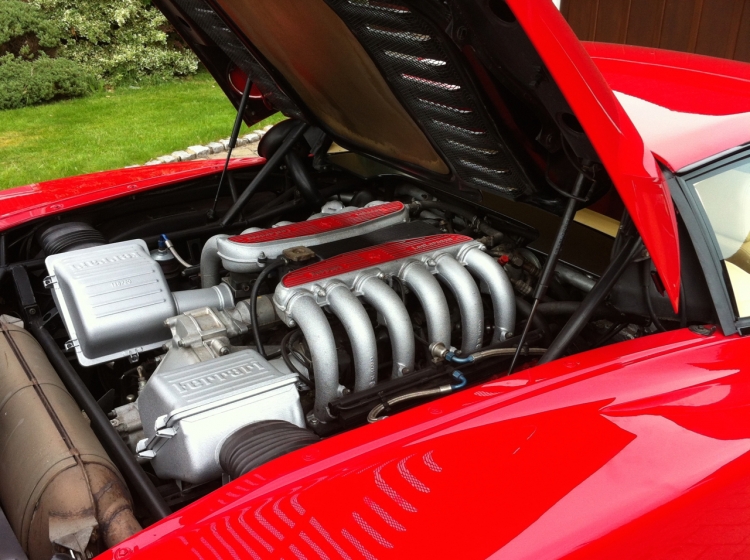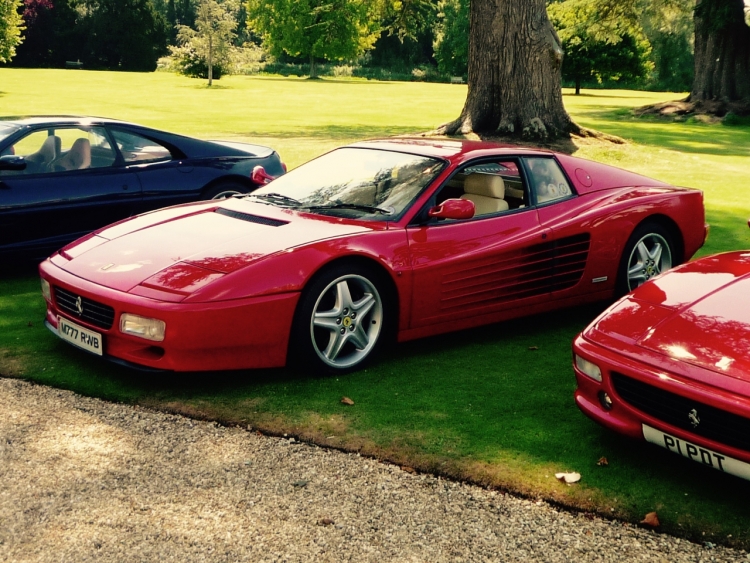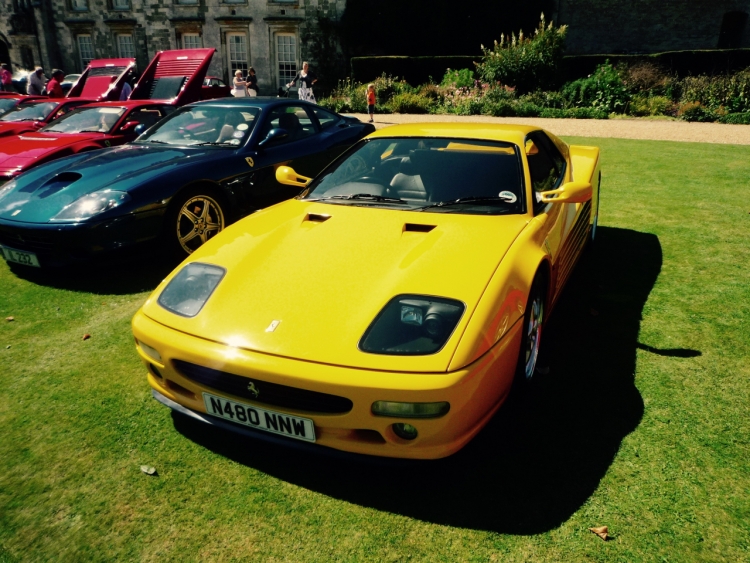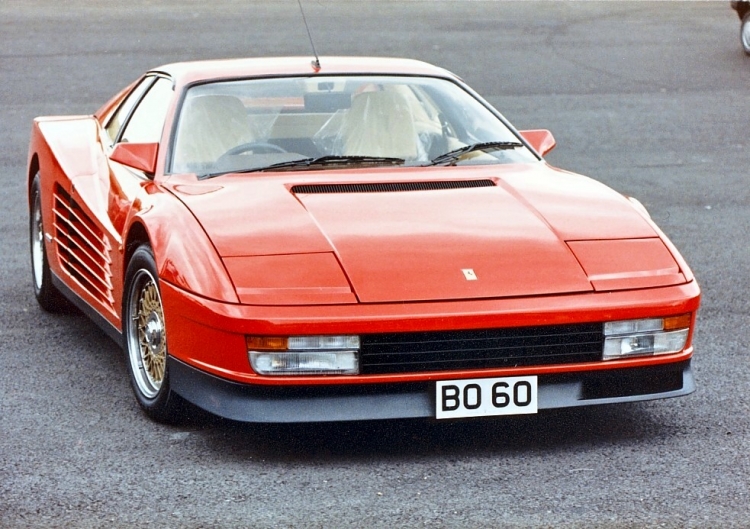Ferrari's 80s icon that became a 90s joke is making a comeback.
In the four years that Drive Cult has been running I’ve written a lot about Ferraris. They're my favourite manufacturer and my personal history with the marque goes all the way back to my first year of life. However, there's one model of Ferrari that I've almost completely ignored in my articles, which is surprising since in many ways it's the most significant 12-cylinder road car that Ferrari has built: the Testarossa.
My lack of interest is possibly due to the fact that the Testarossa is rather looked down upon by many enthusiasts as a product of 1980s excess, and not one of Ferrari's finest cars. Is that a fair assessment of the Testarossa, though? Should it be looked down upon as a big, shoulder-padded clown car or should it be celebrated as one of Ferrari's great achievements? As with my previous discussions of the Boxer and 400 series, I’ll consider the history of the Testarossa and then look at where it sits in today's classic car market.
The Ferrari Testarossa
The Testarossa was launched in 1984 and replaced the 512 BBi 'Boxer' as Ferrari’s top of the range 12-cylinder Berlinetta. The name, which literally translates as 'redhead', was taken from the famous 250 Testa Rossas of the 50s with their red cam covers, but this time Ferrari concatenated the name into one word.
As with the final 512s, power came from a 5-litre flat-12 engine, which now sported 4 valves per cylinder and produced 390bhp in European trim (380bhp for the US versions). Performance was impressive with a claimed top speed of 180mph and a quoted 0-60 time of 5.8 seconds, although some road testers of the day were able to better that.

Those sorts of numbers would have historically have put the Testarossa right at the top of the Ferrari performance tree, but at this time Ferrari also launched a limited-edition GTO, more commonly known as the 288GTO. With its twin-turbo V8 and composite body it easily outperformed the Testarossa with a 190mph top speed and sub-5 second 0-60mph time.
No longer being top dog performance-wise was of little consequence, though, as two significant factors would go on to make the Testarossa and its derivatives the best-selling 12-cylinder Ferrari of all time.
Firstly, the Testarossa was conceived right from the start as a car that could be offered in all markets, meaning that once again Ferrari could offer a 12-cylinder model in its most important market, the United States. It seems amazing today to think that Ferrari never ofiicially offered the Boxer in the States - although its dealers in the US were more than helpful to anyone that wanted to personally import one - mainly because making the Boxer emissions-compliant in the US wasn't deemed worthwhile.
The US market also required a more comfortable car than the Boxer ever was. The earlier car had a small, tight cockpit which was notorious for getting very hot, in part due to the pipes running through the car from the engine to the front-mounted radiators. By contrast, on the Testarossa the radiators were moved to the sides of the car, which in turn dictated the second reason the Testarossa became such a sales success: the styling.
To channel air into the radiators, Pininfarina’s stylists, led by design legend Leonardo Fioravanti, added long strakes down the side of car. The result was an incredibly dramatic shape which may have lacked the classic beauty of the Boxer but caught the outrageous vibe of the 80s perfectly. After the recessions and oil crises of the late 70s and early 80s, the western world was enjoying a period of rapid growth and economic confidence. The rich were happy to flaunt their success and nothing said "I've made it" better than a Ferrari Testarossa.
The downside of moving the radiators to the sides was that the car became very wide. In fact, at 1976mm wide it's still the widest road car that Ferrari has ever sold. That width made the Testarossa less than ideal for piloting down narrow country lanes, especially since the rear is wider than the front. This was not lost on the UK motoring press of the day, many of whom who preferred the Testarossa’s arch rival, the Lamborghini Countach. The Testarossa's case was not helped by mounting the engine over the gearbox (a configuration it inherited from the Boxer), which resulting in a surprisingly high centre of gravity and tricky handling at the limit.
Indifferent press reviews did not deter buyers, though. It arrived on the market just as the classic and supercar boom of the 80s was starting and the Testarossa sold faster than Ferrari could make them, with a waiting list that stretched into years. Buyers who weren't prepared to wait were paying massive premiums to get their hands on new Testarossas, sometimes as much as two or three times the list price. Ferrari quickly realised they were onto a good thing and the list price of the Testarossa had nearly doubled by the time it ceased production in 1991. In its seven-year run the Testarossa changed very little, with a redesign of the wing mirrors and a switch from single knock-on hubs to 5 lug nuts on the wheels being the biggest changes.
The 512TR
By 1991, and after a whopping 7,177 Testarossas had been produced, the market had changed. The global economy had crashed and the flash and glamour of the 80s gave way to the more subtle 90s. The market for classics and supercars had also crashed, leaving many people who had paid big premiums for Testarossa potentially looking at large losses. With this in mind, and with Lamborghini also replacing the Countach with the more powerful Diablo, it was time for the Testarossa to get an update, and a new name: the 512TR.

Externally, the changes were a new front facia that aped that of the new Ferrari 348, a new rear bumper and a new engine cover, which incidentally still carried the Testarossa name on early examples. The 512TR also replaced the Testarossa’s 16” wheels with new 18” five-spoke alloys - the first road car to use 18” wheels.
While the 512TR appeared to be a superficial facelift, the new body hid some more dramatic changes underneath. The chassis was heavily revised with a new one-piece rear subframe that allowed the engine to sit an inch lower in the chassis. This brought significant improvements to the handling, aided by revised suspension geometry. Power was also raised to 428bhp thanks to reworked internals in the engine, and a new single plate clutch improved the gearshift. Performance was improved too, with a claimed top speed of 195mph and 0-60mph now under the five-second barrier at 4.9 seconds. The interior was also updated with a new, more classically styled centre console.
The 512M
Despite being offered during a global recession the 512TR still sold surprisingly well with 2,293 units being sold until 1995 when the 512TR was replaced by the Testarossa’s final incarnation, the F512M.

Mechanical changes were relatively minor this time, with a further increase in power to 440bhp thanks to new titanium connecting rods and a lighter crankshaft. This increased the top speed to 196mph and reduced the 0-60mph time to 4.7 seconds.
Styling changes were more significant, as the none-more-80s pop-up headlamps were replaced with fixed units under Perspex covers. The new headlights also necessitated a new bonnet design. The front facia was again changed to bring the F512M into line with the newly-released Ferrari F355. At the rear, the famous Ferrari round taillights, last seen on the Boxer, returned. The wheel design also changed to a new split rim design by Speedline. The interior was left largely unchanged, but it was now possible to order lightweight carbon fibre bucket seats as an option.
The F512M was liitle more than a last hurrah for the Testarossa line; after just over a year on sale and 501 cars sold, it was replaced by the all-new front-engined 550 Maranello.
The Testarossa's time has come again
Sometimes when a model that is very different in concept replaces a car, it does wonders for maintaining the desirability of the older model, but that wasn't the case for the Testarossa. The 80s were considered a deeply unfashionable period in the 90s (as the 70s had been in the 80s), and the Testarossa was considered very much the poster child of that era and paid the price as a result with nosediving values.
This wasn't helped by a reputation for being a difficult car to maintain. In order to change the cambelts the engine had to come out of the car, which is a time-consuming and expensive process. Curiously, the process of engine extraction is different on the early cars where the engine comes out of the bottom, but the revised sub-frame of the 512TR and F512M necessitated the engine being extracted from the top.
Some enthusiasts also looked down on the Testarossa for its lack of competition history. It was Ferrari's first 12-cylinder Berlinetta not be raced at the top levels of international GT racing, in part due to the lack of a suitable series in which to race it. Even if there had been, the Testarossa wasn't really suited to the track with its high centre of gravity and inaccessible engine.
The combination of an unfashionable image, high maintenance costs and a relatively plentiful supply of used cars caused Testarossa prices to hit the floor. In the early 2000s it was possible to pick up a usable early Testarossa for less than £30,000. The later 512TR and especially F512M also fell in price, though never to those depths. They certainly looked like relative bargains compared to the price of a new Ferrari 360.
Today the market has changed again. The spectacular rise in price of virtually all 60s and 70s Ferraris has meant that buyers are looking at the 80s icon once again. The classic motoring press has also reappraised the Testarossa and seem to have decided that its attributes outweigh its demerits. For a mid-engined car the Testarossa has a surprising amount of room for luggage with a deep storage space in the front and a large parcel shelf behind the seats. It's also very comfortable and makes for a much better long distance GT car than a Countach. A couple of journalissts have even bought their own Testarossas, with Harry Metcalfe buying not one but two early Testarossas and oversteer-meister Chris Harris choosing a 512TR. Harry has recently demonstrated the Testarossa's GT credentials with a long distance road trip to Morocco, and the remarkable video diary for this trip is worth a watch.
This rise in popularity combined with the surge in classic Ferrari prices means that Testarossas have appreciated considerably and are now nudging £100,000, with F512Ms fetching over £200,000. The 512TR sits somewhere between the two. Higher prices have brought a surprising number of very low mileage Testarossas onto the market. Perhaps many of the speculators who got caught when the market crashed the first time around have held onto their cars and are now hoping to get some kind of return on their investment. Just one word of warning if you're looking at buying one of these cars, though; make sure it had those all-important cambelt changes. They need to be changed every three years, even if the car hasn’t been used.
With a combined total of nearly 10,000 units sold, the Testarossa family is the best-selling 12 cylinder Ferrari of all time by some margin, and with Ferrari’s current model cycle strategy I don’t expect these figures will ever be beaten. As such, the laws of supply and demand will dictate that the Testarossa will never challenge the 60s 250s and 275s in value, but that doesn’t mean it isn’t a desirable car.
As a child growing up in the 80s, my Dad had a Testarossa and I loved being a passenger in it. The wide, imposing Testarossa looked and sounded great in my prepubescent opinion, although even then the Daytona still topped it on both counts in my book. I also recall being fascinated by the unfeasibly large vanity mirror that popped up automatically when you opened the glove box. Dad bought the car nearly new in 1985 and for some reason never cashed in at the height of the boom, instead selling the car in early 90s when business commitments had him move overseas. As I got older, I too fell out of love with the shape. Through the 90s and 00s I never really gave the Testarossa much thought, passing them by at Ferrari shows without so much as a second glance.
However, now that I'm a little older still I can see the charms of the Testarossa once again. The Boxer is certainly a prettier car, perhaps the prettiest of all the mid-engined Ferraris, but the Testarossa suits the long distance touring that I like to do far better than its older brother. The early cars have their appeal and it seems the market particularly likes the very early 'flying mirror' cars with the single wing mirror mounted high up on the A pillar, but those 16” wheels put me off. It's perhaps the only Ferrari that looks better on aftermarket wheels, with BBS items looking particularly good:.

The later 512TR and F512M cars are the ones to go for. The F512M has rarity and the best specification on its side, though in my opinion the fixed headlamps look like an afterthought. I’m also not a fan of the split-rim Speedline alloys either.
That leaves the 512TR as the version I would have. It has almost as much performance as the F512M, and is the most visually attractive of the three derivatives. I would probably seek out one of the few examples that aren't painted red, too. A nice gunmetal grey or dark blue would be perfect.
While the 60s Ferraris maybe revered by arch enthusiasts of the Ferrari marque, it's the Testarossa that defines the marque today and brought it so much closer to the wider public. It may not be the ultimate drivers car that its looks suggest, but with the benefit of hindsight perhaps Ferrari never meant it to be. The car for the Sunday morning blast became the limited edition GTO and later on, the F40. Instead, the Testarossa was and perhaps still is the greatest example of a mid-engined GT car.
Photos
Top image by Mr.TinDC via Flickr. BBS-equipped Testarossa courtesy of Mark Shannon - it's actually the Testarossa that Dad owned, but it was returned to factory specifcation by the time he bought it. All other photos by the author.
Video from Harry's Garage.

